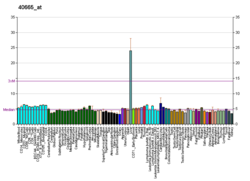Top Qs
Timeline
Chat
Perspective
Flavin-containing monooxygenase 3
Protein-coding gene in the species Homo sapiens From Wikipedia, the free encyclopedia
Remove ads
Flavin-containing monooxygenase 3 (FMO3), also known as dimethylaniline monooxygenase [N-oxide-forming] 3 and trimethylamine monooxygenase, is a flavoprotein enzyme (EC 1.14.13.148) that in humans is encoded by the FMO3 gene.[5][6][7][8] This enzyme catalyzes the following chemical reaction, among others:[8]
- trimethylamine + NADPH + H+ + O2 trimethylamine N-oxide + NADP+ + H2O
FMO3 is the main flavin-containing monooxygenase isoenzyme that is expressed in the liver of adult humans.[8][9][10] The human FMO3 enzyme catalyzes several types of reactions, including: the N-oxygenation of primary, secondary, and tertiary amines;[9][11] the S-oxygenation of nucleophilic sulfur-containing compounds;[9][11] and the 6-methylhydroxylation of the anti-cancer agent dimethylxanthenone acetic acid (DMXAA).[9][12]
FMO3 is the primary enzyme in humans which catalyzes the N-oxidation of trimethylamine into trimethylamine N-oxide;[8][10] FMO1 also does this, but to a much lesser extent than FMO3.[13][14] Genetic deficiencies of the FMO3 enzyme cause primary trimethylaminuria, also known as "fish odor syndrome".[8][15] FMO3 is also involved in the metabolism of many xenobiotics (i.e., exogenous compounds which are not normally present in the body),[9][10] such as the oxidative deamination of amphetamine.[9][16][17]
Remove ads
Ligands
Remove ads
Cancer
The FMO3 gene has been observed progressively downregulated in human papillomavirus-positive neoplastic keratinocytes derived from uterine cervical preneoplastic lesions at different levels of malignancy.[20] For this reason, FMO3 is likely to be associated with tumorigenesis and may be a potential prognostic marker for progression of uterine cervical preneoplastic lesions.[20]
See also
References
Further reading
External links
Wikiwand - on
Seamless Wikipedia browsing. On steroids.
Remove ads







